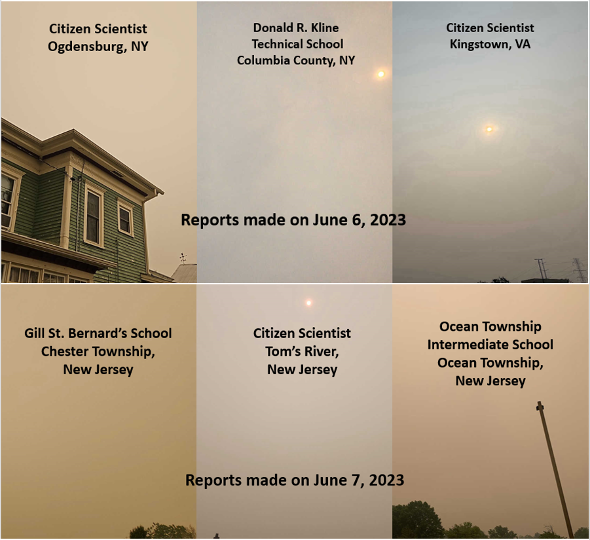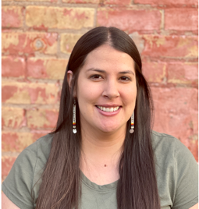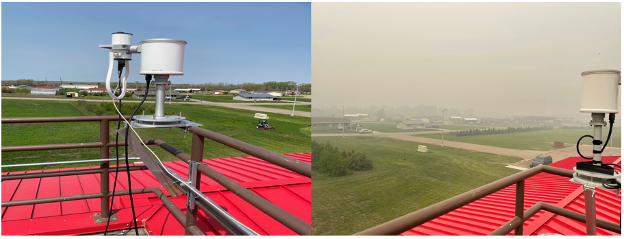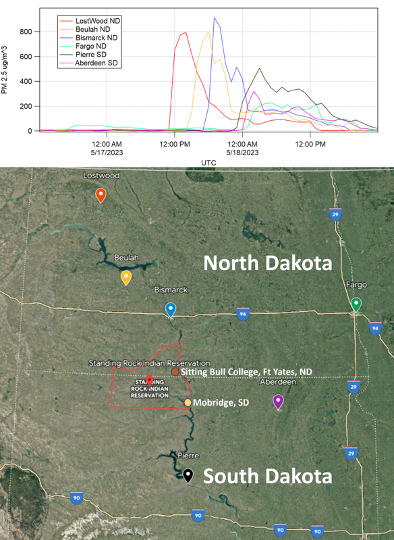News - GLOBE Observer
Fire in the Sky
The United State’s East Coast has experienced smoke plumes from Canadian wildfires in recent weeks, causing air quality issues across the region. With the GO clouds tool, GLOBE volunteers have been reporting their observations and images of this evolving event . If you see or smell smoke from this or any other fire event, and it is safe to do so, we urge you to take a cloud observation. Select “Obscured skies” on the cloud coverage screen, then select “smoke.” Take photos as directed and add the word “smoke” to the caption field of the photograph.

Volunteers submitted observations of skies obscured by smoke in
the eastern United States on June 6 and 7, 2023 through the Clouds
tool in the GLOBE Observer app.
The East Coast is not the only region affected by wildfire plumes. In response, the clouds team has invited a special speaker to share her recent experience with wildfires in her locality.

I live in a rural area, bordering the Standing Rock Sioux Reservation, home to the Dakota and Lakota nations. As Indigenous people, we live in close relationship with the Earth, which we refer to as Mother/Grandmother Earth, or Unci Maka. Our elders teach us to think seven generations ahead in how we care for the natural environment.
We frequently experience hazy skies due to smoke drifting in from wildfires in other areas. The closest EPA monitor is over 100 miles away in any direction, meaning we do not have air quality data being collected and reported for our area. Through my studies I am learning about the health impacts and how important it is to inform the public to assist them in making decisions in regards to their daily activities.

Before and after photographs of the smoke plume as it moved into
Sitting Bull College on May 17, 2023.
As part of my NASA internship, I spent a couple of weeks in early May working with students in grades 3-12, within the Mobridge-Pollock school district in South Dakota. We worked on GLOBE activities learning about sky color, visibility, clouds, and air pollutants. Mobridge-Pollock Middle School has a PurpleAir unit, and I was able to show them how they can check the air quality for our community using the PurpleAir real-time map (check live updates of Mobridge-Pollock Middle School’s PurpleAir unit). The following week we experienced a major smoke event due to Canadian wildfires. The students were able to make connections between the GLOBE activities and what was happening as the smoke moved into the area. It was very exciting for me as the students I had worked with at the school (including my own), explained what they learned and encouraged their friends and family members to check the PurpleAir map!
Thanks to a grant award from NASA, Sitting Bull College is working to establish an air monitoring lab and research center for Standing Rock. This will provide regulatory-grade monitors for our area, which is very exciting. We were on the roof of the new lab installing the Pandora instrument when the smoke event moved into the area. The Pandora instrument measures columnar amounts of trace gasses, like ozone in the atmosphere. The morning started out very clear, with a beautiful blue sky. We watched as the smoke came rolling in, something I had never seen before.

PM2.5 concentrations at different locations in North and South
Dakota as the smoke plume traveled through. PM2.5 are fine,
inhalable particles with diameters that are 2.5 micrometers and
smaller.
This event was very eye opening for me as people throughout the community began to check the PurpleAir website to see the data being collected and reported. On the real-time map, PurpleAir sensors will show a color that correlates to the EPA Air Quality Index (AQI). School officials were able to use the AQI levels to assist with making decisions such as whether or not students should be outside for physical education, recess, and extracurricular activities. I even had a friend in another community reach out to me about acquiring a PurpleAir unit for their community. I realize that the data being collected through these low cost sensors do not provide data for regulatory purposes, but they help provide current and local information for areas away from EPA monitoring stations.
My background is in education, so I love learning and sharing knowledge with others. I think it is important for the general public to have access to data that can impact their health, which is why I have chosen to research smoke impacts. Many people in our communities are dealing with respiratory illnesses and this information is very important to them. During this smoke event, I learned that children are much more susceptible to the harmful effects of air pollution, which is very important to me, personally, as a mother of five children. The more we learn about the air we breathe, the better prepared we are to make vital life decisions regarding our health and safety.
Many communities are facing similar issues related to air quality. Episode three of The GLOBE Program’s Agents of Change series, features high school students of the Mescalero Apache Reservation High School in New Mexico, USA. These students worked with their teacher, Mr. Nate Raynor, installing a sensor at their school and using Mescalero Apache language to write code for the sensors.
You can track the air quality in your area using the Environmental Protection Agency’s AirNow website. You can also use the GLOBE Observer app to make land cover observations in areas that have experienced a change due to wildfires. Dr. Rusty Low wrote a blog explaining how she uses the GLOBE Observer app to make similar reports.
Questions? You can discussion this blog with Samantha Borah and Marilé Colón Robles at the 13 July GLOBE Observer Connect event.
About the Authors:
Marilé Colón Robles is the project scientist for NASA GLOBE Clouds based out of the Science Directorate at NASA Langley Research Center with ADNET Systems, Inc. Marilé works with scientists on ways to include citizen science data into research. She also works with students and teachers around the world to engage students in real-world STEM activities and in authentic science through The GLOBE Program.
Samantha Borah is a NASA intern and graduate student at Sitting Bull College, earning a master’s degree in Environmental Science, with a focus on air quality. Samantha has two years of teaching experience at Standing Rock Community High School and Mobridge-Pollock Middle School. She is also the mother of five daughters.
Comments
View more GLOBE Observer news here.








